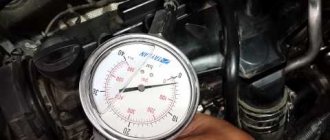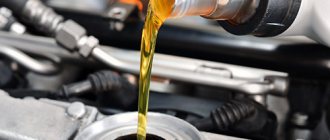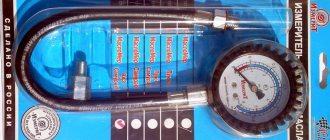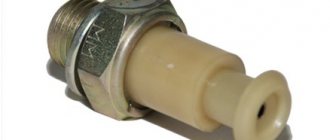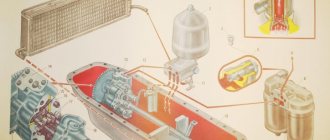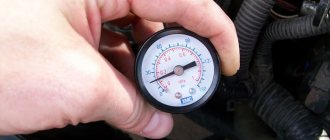Operating a car often presents a variety of surprises, which become difficult issues for the owner. For example, if the oil pressure light in your car comes on while on the road, the problems may be associated with dozens of different mechanisms. The problem is not necessarily the amount of lubricant, although this type of problem is quite possible. An indication of low oil pressure often turns out to be quite a serious signal, after which it is necessary to carry out a full diagnosis of the power unit and repair the unit that has failed.
If your car's oil pressure light comes on while you're driving, you shouldn't wait until the engine completely fails. This light is an indication that there are serious problems with the unit. Many people believe that with the light on, you can drive a few more kilometers to the service station to resolve the problem. In fact, driving with the warning light on, indicating insufficient oil in the system, is impossible. This will have serious and costly consequences.
What to do if the oil pressure light comes on
If on the road you notice that the light with the image of an oil can periodically lights up or starts to shine constantly, you should first stop the car and turn off the engine. The problems can be very different, so it is better not to start the power unit until the problem is investigated. When the car is turned off, you should not immediately run and check the lubricant level, because this way you will not get reliable results. It is worth following a fairly simple algorithm of actions that is available to every driver without exception:
- completely stop the car, turn off the engine to prevent serious problems;
- wait a few minutes until the oil cools slightly and flows into the crankcase through the parts of the power unit;
- remove the dipstick from the crankcase and wipe it with a dry cloth to avoid incorrect level readings;
- check the oil level by inserting the dipstick into place and removing it again, noticing the actual fluid level;
- if necessary, add oil to the crankcase to the normal level (between min and max, closer to max);
- try to start the power unit, and if the light does not go out after starting, immediately turn off the engine;
- call a tow truck or take the car in tow and transport the car to the nearest service station;
- perform detailed diagnostics, find the problem and be sure to completely eliminate it.
This is a simple procedure to follow if the oil pressure light starts to light up or blink. The most common problem with this indication is insufficient oil level. This is especially true for those cars that, for technological reasons, consume a certain amount of motor oil. Do not forget to add fluid to properly lubricate all engine parts. Operating the unit without a sufficient amount of oil is fraught with the most unexpected and unpleasant consequences.
What components can break if the oil pressure light is on?
The question of possible breakdowns is quite complex, since there are a number of variants of problems that are expressed by indicating an incorrect oil pressure indicator. As mentioned above, often it is enough to simply add technical fluid to the crankcase to return the engine to full functionality. Often this solution to the problem does not help, that is, you have to look for other solutions to the problem and conduct detailed diagnostics. This problem is not always related directly to the power unit, but often indicates its malfunction. The main reasons may be the following:
- loss of compression in one cylinder or in several cylinders at once due to high wear of parts;
- piercing the engine crankcase and oil leaking through the hole, as well as a poorly tightened crankcase plug;
- too much wear of the piston group, which causes constant high oil consumption;
- oil pump failure, lack of oil pumping into the engine system and failure indication;
- problems with the crankshaft, which can be very different, but cause oil loss;
- a malfunction of the oil pressure sensor itself, which causes an unreasonable indication of a breakdown;
- closing the contact, which is responsible for demonstrating problems with the engine lubrication system.
A burning oil pressure light does not necessarily mean that you will have to do a major overhaul of your car's engine. Sometimes the problem lies in the electrics, and in other cases it is enough to correct a minor problem with the power unit. But more unpleasant consequences are also possible. Repairs are especially expensive in cases where the driver does not pay attention to the oil sensor light. In this case, you can turn a completely healthy power unit into real garbage that cannot be restored.
The light comes on when the engine is not warmed up
Starting a power unit after a long (at least an hour) inactivity is called a cold start, and this mode is fundamentally different from starting a warm engine.
Ideally, some warning lights on the dashboard come on immediately after the ignition is turned on and stay on for about three seconds after the engine starts. This is a normal situation, explained by the need for the oil pump to start operating, which takes some time to create the necessary pressure in the system. If the light continues to light and goes out after a much longer period of time (about 10 seconds), in most cases this indicates the presence of some kind of malfunction, indicating that small problems can soon develop into serious ones.
To understand the reasons for such situations, let’s take a closer look at how lubricating fluid is cleaned in a modern car. The oil filter, which is a filter element made of paper or synthetic fiber enclosed in a metal housing, is designed to protect the engine oil from contaminants formed inside the circuit and entering from the outside (metal shavings, dust, dirt). Its operation is impossible without an oil pump, which pumps up the necessary pressure to force the oil to move through the channels, passing through the filter. When the engine is stopped, some grease should remain in the filter, at least for a while. If, for a number of reasons, the oil completely and quickly drains into the oil pan, the next time the engine is started, it is forced to operate for some time without lubrication, “dry”. The longer it takes for the oil pump to get the lubricant to the filter, the worse it is for the power unit.
For this reason, starting a cold engine is considered an extreme mode, especially in the cold season, when the engine oil becomes thicker and it takes more time for it to warm up, lubricating intensively rubbing parts. We have already said that the optimal time required to ensure the required oil pressure in the circuit is considered to be an interval of 3-5 seconds. But these figures are purely indicative - much depends on factors such as the design features of the oil pump, other components of the lubrication system, the qualities of the filter element, the condition of the lubricating fluid itself, etc.
In any case, if the oil pressure indicator lights up for more than 10 seconds on a cold engine, this should alert you. Perhaps the reason lies in a malfunction of the pressure relief valve, whose task is to retain lubricant in the oil filter after the pressure drops to zero, that is, when the power unit is turned off. Due to normal wear and tear, this valve, which is a rubber gasket, can wear out/rupture, allowing oil to flow unimpeded into the pan. We have already described the consequences. This part cannot be repaired, so you will have to change the entire oil filter.
Repair work after driving without oil
When an engine is running without good lubrication, the unit has very little chance of survival. Within a few minutes, the wear of the piston group reaches the maximum possible level. Gaining speed in this state of the engine will mean an almost guaranteed loss of vital activity of the unit. It is better to carry out repairs after the car has been evacuated, as soon as the light starts to burn. In this case, you can often get by with little expense. If the unit operates without oil, the problems can increase significantly:
- new problems will be added to existing problems to repair the engine due to its wear;
- the piston group is almost guaranteed to be replaced, which will make repairs unrealistically expensive;
- the entire oil supply system will most likely also be replaced at enormous expense on the part of the owner;
- the repair will have to be carried out at a professional station, because disassembling the engine is not an easy process;
- the use of low-quality parts will not work in this case, since the machine will completely lose reliability;
- A clear computer diagnosis is needed to help identify the affected nodes.
Let's sum it up
An oil pressure light that comes on while driving is almost guaranteed to promise serious problems for the car owner. The easiest problem that is possible in this situation is problems with the electrical system or failure of the oil pressure sensor. Otherwise, repair work will become a rather expensive and very lengthy process. This is especially true in cases where the car owner drives for a long time with the pressure light on.
Indication of any problems in your car deserves due attention. It is dangerous to continue driving a car with almost any problem, because you can damage the vehicle. Modern sensors in cars rarely break down and cause any problems to car owners. Therefore, often the culprit for a light that comes on is an oil problem. Have you ever experienced situations where the oil pressure light came on while driving?
One of the parameters of engine operation is oil pressure. To ensure uninterrupted and high-quality functionality of the power unit, each driver must constantly monitor the maintenance of the required oil level in the engine. If the oil pressure light comes on on the dashboard of a VAZ 2114/2115, you must immediately take some action. The indicator will light up in cases where there are certain problems with the oil pressure in the engine unit system.
Which lights on your dashboard should you ignore?
A modern vehicle is considered the most convenient to use. And this phenomenon is explained by the fact that a large number of electronic systems are used in the design. Some are responsible for the interactive part, while others are directly related to security. For example, a car has many sensors that determine the state of important systems, including the engine, gearbox and other components. In order for the motorist to always be aware of everything that is happening inside the vehicle, indicators are displayed on the dashboard. These are the ones we will talk about today.
How can a new driver learn to determine which indicator on the dashboard is important and which is not? In fact, they are all important. It’s just that some signal minor problems, and when others appear, you need to immediately stop the vehicle and look for the source of the problem. Let's look at which lights on the dashboard are not recommended to be ignored.
Motor overheating . A modern engine cooling system is equipped with a special sensor that determines the temperature of the coolant and the engine. When the indicator goes beyond the threshold values, the system automatically displays a corresponding lamp on the dashboard. Ignoring its appearance is highly recommended. Typically, overheating can occur due to a leak or lack of coolant, a faulty fan, or a broken thermostat. If a problem occurs on the way, you need to stop the vehicle, wait until the engine has completely cooled down, at which time you need to call a tow truck and go to the service center. If you continue to drive and try to get to the workshop yourself, you can cause serious damage to the engine.
Oil pressure . The performance of the motor depends on the mode in which the lubricant operates. If there is increased or decreased movement in the system, it can lead to failure of the power unit. Typically, low pressure occurs due to a leak in the oil circuit, insufficient fluid, or a faulty pump. Manufacturers prohibit you from continuing to drive if the oil pressure light on the dashboard comes on. Sometimes the indicator may light up when the engine starts, and then disappear - this phenomenon does not indicate the presence of problems.
Accumulator charging . As a rule, such a light appears on the dashboard when there is a problem with the generator, which cannot charge the battery. While driving, the generator recharges the battery. If the first one fails, the battery cannot receive energy. This leads to a reduction in resource. When a light appears on the indicator, this may indicate not only a breakdown of the generator, but also a broken timing belt and other defects in the electrical circuit.
Brake fluid . This light comes on when the brake pads are worn out or the brake fluid level is low. In this case, it is prohibited to continue driving. If the requirement is ignored, the brake system may fail, resulting in an accident.
Bottom line . Indicators on the dashboard periodically light up to indicate the status of various systems. Some light bulbs are not recommended to be ignored.
Why does the oil pressure light come on in the VAZ 2114/2115
There are several likely reasons why this car light suddenly comes on. And only based on an accurate determination of the cause can the necessary actions be taken to eliminate the malfunction.
The indicator may light up in two cases:
at engine idle speed;
when the car is moving.
Each of these cases has its own causes of malfunctions.
The indicator in the form of an oil can lights up in situations where there is any problem with the oil pressure
The light came on at idle
The oil pressure light may come on (or blink) at idle, and if you press the gas pedal, the icon will immediately go out. In this case, the most likely causes of malfunctions are the following:
the crankshaft liners are worn out: the oil pressure will drop due to the fact that the gap between the thinned liner and the car’s connecting rod has increased;
the oil receiver mesh is severely clogged: one of the most common reasons why a light bulb suddenly lights up. Various types of sediment are gradually deposited on the surface of the engine sump. At the moment when there are too many deposits, the pump can no longer supply enough oil to operate the engine;
wear or any problems in the oil pump: another probable reason why the indicator may light up on a VAZ 2114/2115. Due to a breakdown of the pump itself or any part of it, oil does not enter the engine in the required quantity;
the sensor is faulty: it is quite possible that the oil level and the engine itself fully meet their basic characteristics, and the problem lies in the sensor;
the wiring is shorted: problems in the car’s electronic system can also cause the engine oil supply system to not operate correctly.
The oil can indicator light came on while driving.
In cases where the oil pressure light suddenly comes on while the car is moving, it is advisable to stop immediately. Probably the following failure or breakdown occurred:
the oil level in the engine unit is below the Min mark;
the oil filter could be clogged - this leads to the fact that the pressure invariably decreases;
it's time to change the oil - in cases where the car owner does not replace the substance in the engine for a long time, it loses its working properties.
What to do when the oil pressure light is on in a VAZ 2114/2115 car
Depending on the cause of the malfunction, the driver’s actions will differ when this indicator lights up.
If the oil pressure light in a VAZ 2114/2115 lights up when the engine is fully warmed up and the car is stopped (idling), the following actions will be required:
If the cause of the malfunction is wear of the crankshaft liner, serious car repairs will be required. Depending on the general condition of the machine, you may need either a complete replacement of the crankshaft, or large-scale repair of the shaft and replacement of the bearings with new ones. It is advisable to contact a car repair shop.
In the event that the oil pressure has dropped due to debris and deposits in the receiver grid, each driver can independently eliminate the cause of such a malfunction. It is necessary to clean the mesh and also remove accumulated debris and adhered dirt from the tray. It is also recommended to flush the engine with special flushing oils at the next oil change.
A faulty oil pump can only be removed in one way - by replacing the pump itself. If the car owner does not understand the design features of the VAZ 2114/2115, then it is also better to seek help from specialists.
If the oil pressure sensor is faulty, it is also recommended to replace it. It should be noted that recently, more and more often, owners of domestic cars are diagnosing problems with pressure sensors. This is explained by the fact that auto shops and car markets often sell spare parts of dubious quality.
It is better to entrust the search for a short circuit in the wiring to an auto electrician.
Video: the oil pressure light came on at idle, what to do
However, what should be done if the oil pressure light comes on while driving? The first step is to stop on the side of the road or in any convenient place where the car will not become a hindrance to other road users:
After stopping, it is advisable to check the oil level in the engine unit. It is quite possible that its level is below the Min mark, which is why the indicator in the cabin came on. It is necessary to add working fluid and continue driving. If the light comes on due to lack of oil, then the problem is considered solved.
Oil indicator is on - Octavia A5
If the yellow oil light is on, the oil is normal; after you take out the dipstick and put it in place, it goes out. After 3-4 days everything repeats itself - here are the reasons:
1. The oil level sensor in the pan is faulty. To check the serviceability of the sensor, we perform diagnostics with a cord. There will be an error: 9453842 - Temperature and oil level sensor. The sensor is located on the crankcase oil pan. Catalog number of the oil level sensor - 1J0 907 660 C / 1J0 907 660 F original / Analogues: HELLA 6PR 008 079-071, DEPPUL DEC6097VAG, ROERS-PARTS RP1J0907660F
Also, check the harness itself, the wire may have broken off.
2. There is not enough oil, literally 100 grams is enough for the oil can to start burning.
Let's start with something simple. Add oil. After topping up, the indicator may continue to light. For the indicator to go out, you need to start the engine with the doors, trunk and hood closed. We put the box in neutral/parking.
Now, turn off the engine, open the hood and driver's door. We wait 5 minutes. Close the hood and door, turn on the ignition.
The oil can is on - Skoda Octavia 1.8 tsi, 2011.
There is compression. Replacing both pressure sensors - the oiler is on. I changed the oil filter - the problem remained. Oil pump - no play. The oil receiver is not clogged - the pan is clean.
With the oil heated, we measured the pressure at xx 1.5. At 3.5 revolutions 2.5. At higher levels there should be min 3.
Answer
1. Switching from 0w30 to 5w30 may help. These engines do not push through it over time.
2. Check the oil pump, oil filter, valve under the filter. As a rule, replacement solves the issue.
3. Check the wear on the liners when you remove the pan.
The oil is normal, and the light on the panel when starting the car blinks 3 times and goes out
The essence of the problem is outlined in the video. Based on the results, the author of the question himself wrote that it was a malfunction of the oil level sensor. The oil is normal, but the light on the panel blinks and goes out 3 times when starting the car. Or it may light up, when checking the level - everything is normal. Now every time it just blinks and then stops.
It was like it was blinking, I turned it off, then I opened the hood, pulled out the dipstick, looked at the oil, it was normal. I started it up and didn't blink. Then after a while it started flashing again. Do this every time before starting.
Therefore, we definitely check the sensor. If not him, then we need to look.
When the oil pressure flashes, the problem may not be with the sensor. The filter is clogged, the oil channel is clogged, the liner is turned, the oil is liquid. Better have a good look.
In the pan there is a mesh on the oil intake. Maybe until the oil warms up and becomes liquid, it doesn’t draw well because the mesh is clogged. Maybe the oil pump.
Collections on the topic:
Who's 1.6 Octa A5 is burning oil in 2012?
— survey of Shkovodov Eats oil on the highway — in the city — normal — Octavia 1.6 MPI
Maslozhor: what kind of thing is it - how and with what it is eaten
How much oil should I put in a 1.4 tsi?
Oil level dipstick guide tube Skoda A5 - price and part number
What oil is better to use?
The valve cover is a little oily - Skoda 1.6
There is an unknown yellow substance on the oil filler cap
The role of the oil pressure indicator
The red light, marked on many cars with the image of an oil can, was added to the dashboard for a reason. It is connected to a common electrical circuit with a sensor mounted in one of the channels of the engine lubrication system. When the element detects a pressure drop below a critical level, the circuit closes and the lamp flashes red, informing the driver of an emergency malfunction.
The signal from the red lamp with the image of an oil can indicates a malfunction of the engine lubrication system
In some modern cars, the power unit is equipped with not one, but two sensors: high and low pressure of engine lubrication. The first monitors the operation of the engine under load, the second - at idle. Both elements are included in a circuit with one indicator that reacts to impulses coming from them. Operation thresholds are 1.8 and 0.3 Bar, respectively.
The purpose of the emergency lamp is to warn the car owner in time about the engine's oil starvation. If for various reasons it does not light up or the driver ignores the red “oil can” signal on the instrument panel, then the following consequences may occur:
- due to lack of lubrication, the crankshaft journals wear out, the sliding bearings (liners) may rotate and eventually jam;
As a result of oil starvation, wear develops on the crankshaft journals. - In the absence of oil, the piston skirts will overheat and expand in volume, leaving scratches and scuffs on the cylinder walls;
A poorly lubricated piston heats up and leaves marks on the cylinder wall - the camshaft bearings located at the highest point of the engine will fail;
Without lubrication, camshaft bearings quickly fail - the service life of the remaining rubbing parts will be sharply reduced.
Insufficient amount of lubricant or its absence in any case leads to breakdown and costly repair of the power unit. A timely signal on the dashboard will help avoid this.
List of faults that cause the lamp to light up
So, if you notice that the battery icon on the instrument panel is on and does not go out, you can conclude that it is not charging. There may be several reasons for this:
- the charge is either completely absent or so small that its value is less than the potential difference at the battery terminals;
- the lamp control relay has failed;
- the contacts of the circuit elements are burnt, oxidized or weakened (on the battery itself, on the ground wire, on the generator).
Let's look at these cases in more detail.
What does the lamp indicate?
The indicator light on the dashboard reacts strictly to engine oil pressure. Due to the level being reduced within reasonable limits, the signal will not appear on the panel. The exception is the loss of 2/3 of the lubricant when the oil intake of the pump begins to pick up air and crankcase gases. Then the pressure in the lubricating channels will inevitably drop, to which the sensor will react and the light will light up.
When the level in the sump drops to a critical level, the pump draws in oil with varying intensity due to vibration and movement of the vehicle. The “oil can” on the instrument panel begins to blink, and if the level drops further, it will remain on continuously.
The circuit, signaling problems with lubrication of the power unit, consists of parts that also periodically break. So a flashing lamp does not always mean fatal engine failure. But if it lights up on your car, then you need to act like this:
- Stop moving.
- Turn off the engine.
- Check the lubricant level and add up to normal if necessary.
The lubricant level in a car engine is checked with a special dipstick - Topping up did not work - transport the car to the garage or to a car service using a tow truck or in tow.
- If the indicator light is intermittent (flashing), then move to the repair site under your own power at low speed. Monitor the coolant temperature gauge and pressure light: when it stops flashing and lights up, immediately turn off the engine.
In your garage, you can find the cause of the alarm if you follow the steps below.
Video: the light came on while on the road - what to do
Change in oil viscosity
Filling the engine with a lubricant of a different viscosity makes itself felt immediately. The signs are as follows:
- Thicker oil causes a pressure surge when starting a cold engine, and the light goes out at idle. After heating, the material liquefies, but the sensor still does not work. The actual pressure value can only be determined using a mechanical pressure gauge.
- Too thin a lubricant can cause the indicator to blink or light up at idle, and at 1500-2000 rpm the light goes out. This picture is observed on a “hot” engine, but on a cold engine there is no alarm signal.
The behavior of the indicator depends on the consistency of the lubricant. Due to too thin oil, the lamp can flare up even when it is cold.
A more insidious malfunction that causes the alarm to flash is the failure of the spark plugs or fuel supply system. In the first case, the air-fuel mixture does not burn completely in the chambers, and in the second, leaking injectors literally flood the cylinders. In both cases, unburned gasoline flows into the crankcase, mixes with the engine oil and dilutes it, causing the pressure to drop and the “oil can” to flash.
Gasoline leaking into the pan is characterized by the following symptoms:
- the indicator flashes after warming up at low engine speeds, and goes out at high speeds;
- when you press the accelerator pedal, a failure is observed - the engine “chokes” from over-enrichment of the mixture;
- “when cold” there are no symptoms of a malfunction.
It is easy to verify the problem: with the engine warm and running, remove the hose leading from the crankcase to the throttle valve air duct (or to the air filter on the carburetor). If the operation of the engine is leveled out, and a strong smell of gasoline comes from the removed pipe, then this is the reason. Repair the fuel system and install new spark plugs, then replace the engine lubricant.
To detect fuel in the oil, you need to remove the crankcase ventilation pipe.
If, for various reasons, you forgot to change the oil on time and continue to drive, then the flashing red signal of the “oil can” will remind you that the material has developed its lubricating properties and has turned into black water.
Engine problems
These are the most serious malfunctions associated with wear of engine parts. They are characterized by a constant burning of the oil pressure lamp in all modes, including while driving. An additional symptom is a dull knock at the bottom of the cylinder block. What could cause:
- the most harmless option is complete blockage of the oil receiver mesh;
Sometimes, to restore normal pressure, it is enough to flush the oil pump mesh - a dent on the crankcase, limiting access of lubricant to the pump (the pan fits closely to the mesh);
- wear of oil pump parts - increased gaps between gears, loss of seal tightness, shaft play;
- critical wear or breakdown of the oil pump drive elements that transmit torque from the crankshaft to it;
When wear appears on the drive splines, play occurs on the oil pump shaft - worn out crankshaft liners, allowing all the oil to pass through them back into the crankcase, which is why it does not reach the cylinder head and the sensor.
To get to the oil pump and crankshaft, you need to unscrew and remove the pan
Most of the listed problems require the intervention of a master mechanic. The exception is a crumpled tray (to be replaced) and a clogged mesh, which you can clean yourself. To do this, you will have to unscrew the engine from the mountings, lift it with a jack and remove the oil pan. An autopsy will certainly show whether the repair will cost just cleaning or whether the pump needs to be removed and inspected.
As a rule, trouble does not come alone. A large amount of dirt, carbon deposits and chips that have accumulated in the crankcase of the power unit and can tightly clog the oil pump screen are the result of a high mileage of the engine. If you see a similar picture on your car, you should think about partial or major engine repairs.
